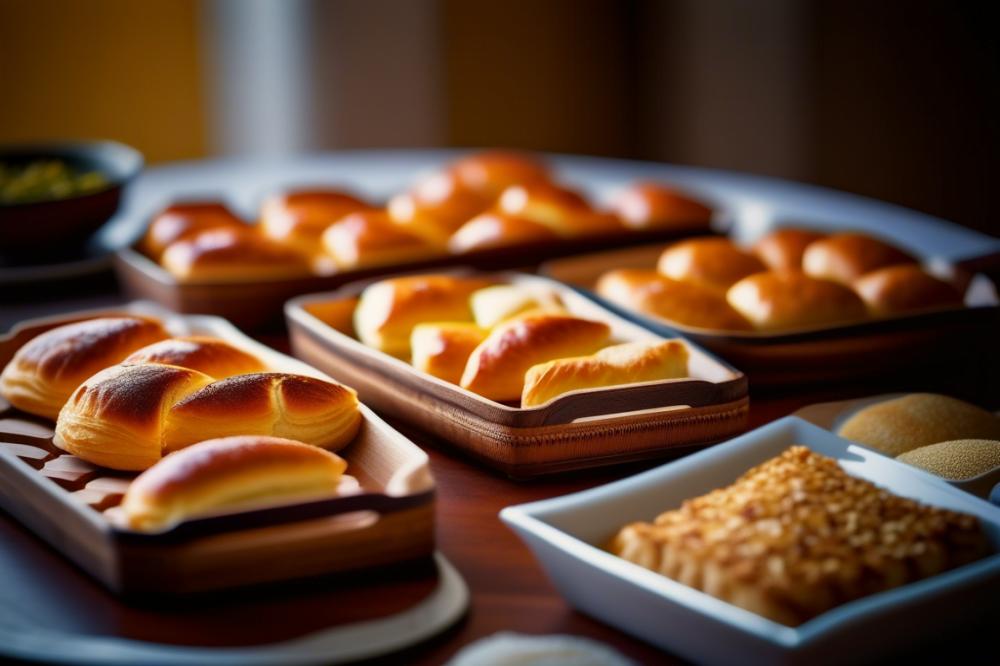Exploring Greek Bourekia
Culinary travel enchants many, offering a taste of diverse cultures and traditions. Greece, with its stunning landscapes and rich history, often ignites wanderlust in food lovers. Among the treasures of Greek cuisine, one dish captures the imagination: Greek Bourekia. These delightful savory pastries hold a special place in the hearts of many. They symbolize a connection to tradition and family gatherings, often being prepared for festivities or shared between friends.
The process of making Bourekia at home is more than just cooking; it’s a journey through Mediterranean culture. Using ingredients like feta cheese and spinach, anyone can recreate this beloved Greek pastry. The thin sheets of filo dough, with their flaky texture, are part of what makes this dish so wonderful. The aroma of baking Bourekia fills the kitchen with warmth, reminding us of those unique rustic tavernas found in Greece.
Recreating an Authentic Bourekia Recipe brings joy and a sense of accomplishment. This experience connects individuals to generations past, who lovingly crafted these pastries from scratch. Family recipes often come to life with simple cooking tips passed down over the years. Through this culinary adventure, you not only make a delicious meal but also celebrate the culture behind each bite.
Understanding Greek Bourekia

Greek Bourekia are a type of savory pastry that hold a special place in traditional Greek food. These delicious treats can be filled with various ingredients, making them a favorite across the country. Many people enjoy them as snacks or as part of a meal. They are commonly made with flaky filo dough, which gives them a light, crispy texture.
In Greece, different regions showcase unique variations of Bourekia. Some popular fillings include feta cheese and spinach, a classic combination that many adore. Others may feature ground meat, herbs, or vegetables. For example, in some areas, you might find a version stuffed with cheese and tomatoes, while in others, rice and vegetables could take center stage. Each locality brings its own twist to this beloved dish, making them truly special.
Preparation methods can also vary. Bourekia can be baked to a golden perfection or fried for a crispier texture. Homemade versions often highlight family recipes passed down through generations. Everyone has their own cooking tips to share. Whether you use store-bought filo dough or prepare it from scratch, the choice is yours. The beauty of Bourekia lies in their versatility.
As a staple in Mediterranean cuisine, these pastries represent the essence of Greek comfort food. Some may serve them as appetizers during festive gatherings, while others enjoy them as a hearty lunch. Regardless of the occasion, Bourekia never fail to please. With their rich history and delightful fillings, they remain a cherished part of Greek culinary tradition.
Gathering Ingredients

Creating authentic Greek Bourekia starts with gathering the right ingredients. The key component is filo dough, which gives the pastry its signature flaky texture. You can find this dough in the frozen section of many grocery stores. Look for brands that focus on quality; this will make a significant difference in your dish.
Feta cheese is another essential ingredient. It adds a rich, tangy flavor to the filling. Consider using sheep’s milk feta for a more traditional taste. Local markets often sell high-quality options that can elevate your bourekia. Check the expiration date to ensure freshness.
Spinach forms the backbone of the filling, providing both flavor and nutrients. Fresh spinach is recommended, but frozen spinach can also work in a pinch. If you choose frozen, make sure to drain it thoroughly to avoid excess moisture.
Don’t overlook the importance of herbs and spices. Fresh dill, parsley, and even a sprinkle of nutmeg can enhance the overall flavor. Mediterranean cuisine thrives on fresh ingredients. So, if possible, visit a local farmer’s market for fresh herbs. They can really bring your savory pastries to life.
While assembling the necessary ingredients, pay attention to how you handle the filo dough. It can dry out quickly, so keep it covered with a damp cloth while you work. This simple cooking tip will help maintain its moisture and pliability.
The choice of olive oil also matters. Use a good quality extra virgin olive oil for brushing the layers of filo. This adds a depth of flavor to your bakings. A little goes a long way, so don’t feel like you need to be excessive.
When creating these homemade pastries, remember that every ingredient plays a role. The harmony of flavors in traditional Greek food shows respect for simple, quality ingredients. By focusing on each component, you set the stage for delicious bourekia.
Prepping the Dough and Filling

Creating Greek Bourekia starts with making the right dough. Filo dough is delicate and requires gentle handling. It often comes frozen, so you need to thaw it properly before use. Plan ahead; leave the dough in the refrigerator overnight. Once it’s ready, keep it covered with a damp towel to prevent it from drying out. Working with filo can be tricky, but patience goes a long way. You’ll want to layer the dough for that perfect flaky texture.
Now, let’s get started on the filling. A delicious feta and spinach mixture is traditional. Fresh spinach is usually preferred for its vibrant flavor, but frozen can work in a pinch. If you choose frozen, make sure to thaw it completely and squeeze out excess water to avoid sogginess.
Next, crumble the feta cheese in a bowl. Mixing in chopped fresh herbs like dill and parsley enhances the filling’s brightness. Season with salt, pepper, and a hint of nutmeg for warmth. Using nutmeg might surprise some, but it adds a unique twist to this Mediterranean cuisine. Incorporate the prepared spinach with the feta, taking care to blend everything evenly.
Now that your filling is ready, it’s time to work with the dough. Lay a sheet of filo on your clean workspace, and brush it lightly with melted butter or olive oil. Layer another sheet on top, repeating this process for about three layers. This layering technique produces a light, crispy pastry. It’s crucial to use butter or oil generously, as this method gives your final product that sought-after flakiness.
After layering, cut the dough into rectangles. Spoon a generous portion of the filling onto the bottom half of each rectangle. Fold the pastry over to form a triangle. Press down the edges neatly to seal in the flavorful filling. For an extra touch, you might brush the tops with more butter before baking. Baking these savory pastries in a hot oven allows them to achieve their golden color and crisp texture. A well-timed bake will have everyone enjoying these bites of traditional Greek food.
Baking the Bourekia

Making homemade Greek pastry can be a rewarding experience. The key to perfecting your bourekia lies in the shaping and baking process. Here’s a step-by-step guide to help you create these savory pastries filled with delicious ingredients.
Start with your layered filo dough. Lay one sheet on a clean surface and lightly brush it with olive oil or melted butter. Repeat this with a few more layers, as this will give your bourekia a crispy texture. Then, cut the dough into squares or rectangles, about 5 inches wide. The exact shape doesn’t matter, but uniformity helps with baking.
Once you have your dough cut, it’s time to add the filling. A traditional mixture could include feta cheese and spinach, but feel free to get creative. Consider using ground meat, herbs, or even mushrooms. Place a spoonful of your filling in the center of each piece of dough.
To fold the bourekia, bring one corner of the dough over the filling to form a triangle. Press the edges together to seal them tightly. Then, fold the triangle over again to create a smaller triangle. Ensure no filling leaks out. Repeat with the remaining dough and filling.
For the baking, preheat your oven to 375°F (190°C). Line a baking tray with parchment paper to prevent sticking. Arrange the shaped bourekia on the tray, leaving space between each one. Brush the tops lightly with olive oil or an egg wash for a golden-brown finish.
Now, let’s discuss some cooking tips for that perfect bake. Bake the bourekia for 20-25 minutes, or until they’re golden and crispy. Keep an eye on them after the 15-minute mark, as ovens can vary. If you prefer, you can also sprinkle some sesame seeds on top before baking for an extra crunch.
Should you want to mix things up, consider trying different fillings. Instead of spinach and feta, experiment with ricotta and chard or a mixture of spiced potatoes. The beauty of Mediterranean cuisine is the variety and creativity you can apply to your dishes.
By following these steps, you’ll surprise yourself with the outcome. Homemade Greek bourekia can take some practice, but the results will definitely impress your family and friends.
Serving and Enjoying Greek Bourekia
Greek bourekia offer a delightful experience, both in flavor and presentation. One classic way to serve these savory pastries is by placing them on a large platter, inviting everyone to dive in. While they shine on their own, certain accompaniments can elevate their taste. Tzatziki, a creamy yogurt and cucumber dip, adds freshness. Additionally, a side of warm, roasted tomatoes complements the flavors well.
Pairing bourekia with a light Mediterranean salad makes for a balanced meal. Fresh vegetables, drizzled with olive oil and lemon, enhance the dining experience. These pastries can also be enjoyed alongside olives and artichokes. Such combinations stimulate the palate and echo traditional Greek food.
In Greece, sharing dishes is a cherished ritual. Bourekia are often found at family gatherings and celebrations, symbolizing hospitality and warmth. During a recent trip to Crete, I attended a local festival where these pastries were abundant. People gathered around, sharing stories and enjoying each other’s company with each bite. It was enchanting to watch families pass around trays, laughter filling the air.
While making homemade bourekia, remember that using quality ingredients makes a big difference. Filo dough requires careful handling, yet with practice, it becomes easier. Many chefs share cooking tips about brushing every layer of dough with melted butter for extra richness. Feta cheese, often combined with spinach, provides a tangy filling that bursts with flavor.
Some might even personalize their recipes by adding herbs like dill or parsley. Experimenting in the kitchen reflects the vibrant traditions of Mediterranean cuisine. When preparing these pastries, the aroma alone can evoke fond memories of Greek islands. Each bite of bourekia tells a story, connecting us to the past and encouraging us to create new memories.
Next time you cook bourekia, consider the social aspect. Offer them to friends or family, and watch how they gather around. Creating a warm atmosphere around food enhances the overall enjoyment. Sharing meals, especially something as beloved as these pastries, nurtures connections and builds community.
So whether you savor them for breakfast or serve them at dinner, remember that each pastry is more than just food. Bourekia represent a slice of Greek culture, inviting you to partake in a timeless tradition.
Embracing Home Cooking with Bourekia
Creating authentic Greek pastry like Bourekia can be a delightful experience. The process brings together rich flavors and textures, transporting your kitchen straight to the sunlit shores of Greece. Start with preparing your filling, be it cheese, spinach, or a meat mixture. Each option offers its own taste adventure. Then, rolling out the filo dough can feel like a slight challenge, but it is truly rewarding.
Attaching each layer carefully makes a noticeable difference. Those delicate sheets create flaky, golden layers when baked. Folding or shaping the pieces is an opportunity to express creativity. Different shapes allow for unique presentation on the plate.
By baking Bourekia at home, you connect with Mediterranean cuisine in a meaningful way. Each bite of the finished product will remind you of warm evenings spent sharing good food with friends and family. Trying out this recipe can inspire confidence in your culinary skills. Cooking is about exploration and enjoyment, providing a way to express love through food.
So, don your apron and dive into this delicious journey. Just imagine savoring warm Bourekia, seasoned perfectly, right from your own kitchen. Ultimately, making these pastries connects you to the rich culture of Greece. Enjoy every moment spent creating them, and embark on more adventures in Mediterranean cooking.



